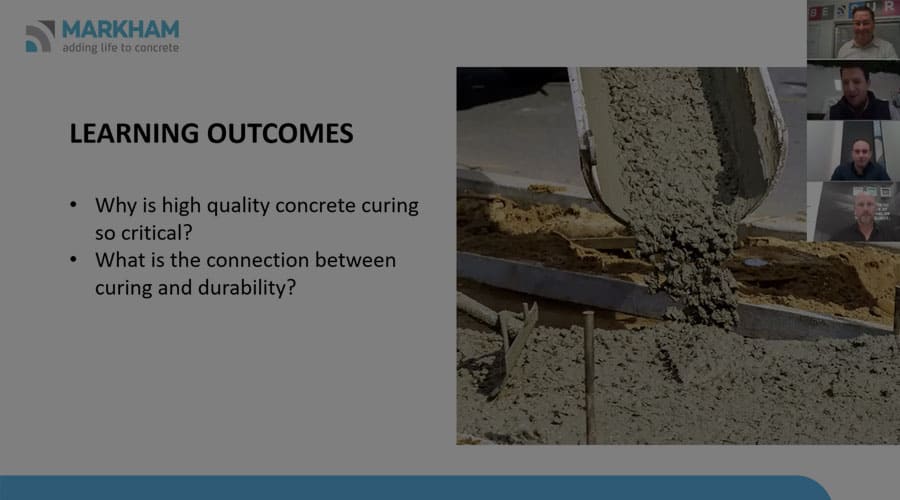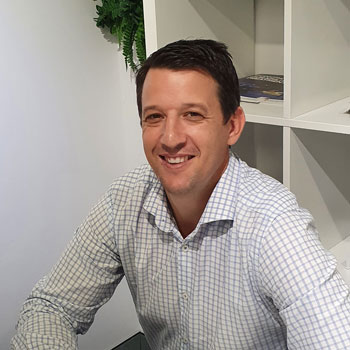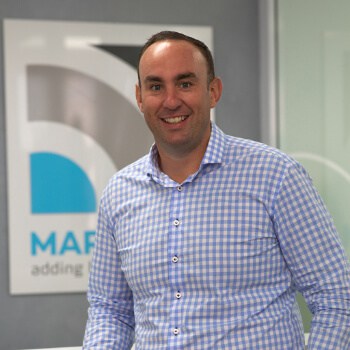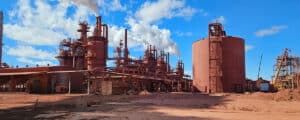Concrete Curing for Today and Tomorrow

Concrete Curing for Today and Tomorrow
Webinar Show Notes
Simply Cracking! markhamglobal.com/simply-cracking
How does AQURON actually work? markhamglobal.com/how-does-aquron-actually-work
Thermal curing protection markhamglobal.com/thermal-curing-protection
Learning Outcomes
- Why is high-quality concrete curing so critical?
- What is the connection between curing and durability?
BRENDAN: All right, looks like we can take off. Good day, everyone! Great to have you with us today. We’ve gathered a fresh panel from the experts at MARKHAM, and we’re keen to get into the science and practical challenges of Concrete Curing for Today and Tomorrow.
We’ll quickly introduce ourselves before we dive in. I’m Brendan Stead, Marketing Coordinator, based in Bundaberg, Australia. I’ll be chairing the discussion including passing on your questions. On our panel today, we’ve got Hayden Prestidge who’s joining in out of Auckland; Mark Cockburn from our Napier office; and Will Pepping who’s in Sydney. Hayden, can you tell us a little bit about yourself, and the others can follow on?
HAYDEN: Yes, it’s good to be on today. As Brendan said, I work across New Zealand and Australia projects on the sales and marketing side. But very keen to be part of this one, it’s a good topic; concrete curing and why it’s so critical for long-term durability really. I’ve been with MARKHAM for just over six years and came into the construction industry. So that’s a little bit about me. Mark?
MARKCO: Good day, everyone. My name is MARKCO. I’ve been with MARKHAM for just over 12 months now. I came on board last March as the Operations Manager for Australia and New Zealand. So predominantly just looking after the application side of the work we do, which things like concrete curing have a direct impact on that. So really looking forward to today’s little webinar and just noting a few things out with everyone. Over to you, Will.
WILL: Thanks, Mark. My name is Will. I’m based in Sydney, Australia. I work predominantly on architectural design and delivery of projects in the construction space. So I worked alongside Hayden in the earlier phase, and assist Mark in the operation phase as well. As Mark said, a really cool topic today. Definitely, in Australia, we find curing is very important, just based on the heat and the temperatures over here. So looking forward to answering any questions; don’t be shy. If I can’t answer them, I’m sure Hayden and Mark will be able to help you guys out, so fire them across.
BRENDAN: Thank you so much, everybody. So the presentation will be about 20 minutes, and as Will mentioned, it will be followed by a live Q&A. You’ll find a Q&A button in the bottom toolbar, and we’ll be happy to look at those at the end of the presentation. So without further ado, we’ll kick this off. Hayden, can you tell us a bit about the basic science of concrete curing?
HAYDEN: Yes, absolutely. So a lot of people think of concrete curing as concrete drying out; you pour your slab, you leave it and it dries out, and then it cures and goes out. It’s actually the opposite of that; concrete cures by retaining its moisture. So we all know standard concrete is made up of cement, then you’ve got your stones, sand, and water. There’s a chemical reaction going on with the cement and the water, and that’s what’s needed. So that moisture is really needed for curing.
A lot of people talk about air curing and things and just leaving that concrete. But you’re really not giving concrete the space from day one. Curing is all about moisture retention. Being able to feed that cement and to grow what we call Calcium Silicate Hydrate, pour those molecules inside the concrete and really bind the concrete together and create its strength. Does that make sense?
BRENDAN: Yes, that’s good. So the strength of the concrete is tied up with the curing process. Is that right?
HAYDEN: Yes, very much so. I mean, the strength of concrete comes from various factors: cement contents and the volume of mix and design and things like that. But a big portion of that is actually curing, and that gets overlooked by a lot. You design your mix right, you bring it to the site right, it’s mixed right, and then it’s pulled in place well. But then it may be left and not cured, and that’s really providing some areas where subsequently it will move forward for premature deterioration really. So yes, it’s a good point.
BRENDAN: Fair enough. So I guess we should be talking about the flip side of that. No doubt everyone’s being very careful to follow best practices on site. But Mark, do you see a few things as probably a Project Manager, what actually goes wrong?
MARKCO: Yes, absolutely. One of the big factors we encounter, obviously, is the environmental effects. Across New Zealand and Australia, we face very extreme sides of those elements. Obviously, we get the very hot, as well as the very cold. These do have a direct impact on the curing of the concrete, which in turn relates to the overall performance and durability of the concrete.
Hot, humid, windy conditions will essentially make your concrete set faster, which may seem like a good thing at the time; you will get high early strength in your concrete. But overall, you will get reduced durability. As you’ve got such a fast high early strength, it will actually slow the overall strengthening process of the concrete as it ages, which can directly impact the durability and the life of the concrete.
Plastic shrinkage cracks are another issue that we come across, under heat conditions. That’s just the water evaporating too quickly out of the concrete, and it just starts to form those cracks across the top, which no one really wants, especially if you’re going for an exposed slab.
Probably more so here in New Zealand, the cold conditions down the deep south, that has a different impact, obviously, on the concrete. It actually slows your hydration process, and in extreme cases — the below-freezing cases — it can actually stop it completely. This can really impact the overall strength of your concrete, not only at the beginning but long term. But especially at the beginning, because it’s such a slow process. The concrete is more susceptible to cracking because it doesn’t have the strength to resist any expansion or movement in those earlier days with the concrete. So that’s some of the issues we come across.
Another thing is bleed water. Bleed water in the concrete is a good thing. Essentially, it’s just free water that hasn’t reacted with the other products in there. So it’s just sitting there free. As the heavier aggregates settle, it pushes the free water up, and that starts to come out through the surface.
Now, with good and normal bleed water, you’ll see a nice uniform layer across the surface; it’ll be just nice and natural. But when that becomes trapped and you start to form channels, that can cause some bigger problems like weakening the bond between the paste in your aggregates, as well as the actual paste and aggregate and reinforcing. I think Will is going to talk a little bit about porosities in concrete and how it has an overall impact on the life cycle of the concrete.
WILL: Thanks, Mark. One little point I’d like to reinforce a little bit there is, there is actually a big misconception about not needing to cure in cold temperatures. We find that New Zealand, and some parts of Australia, obviously do get pretty cold. I have come across several people in the industry who have that conception that you don’t need to cure in the winter months because of the temperature. It’s just a bit of a reverse.
MARKCO: Yeah, we do see that a bit. The reality is you still need that moisture in the concrete. But again, you don’t want it to freeze because that can cause you really big issues. It’s a different sort of curing in the winter. Obviously, we use our AQURON products that go in and they cure it internally. But externally, it’s also about keeping the surface at a good constant temperature; you can use things like heated formwork, thermal blankets are another good one. It’s just maintaining a constant temperature for about three to seven days on that concrete, to ensure that you’re still getting your strength gains overall.
WILL: Thanks for that. I’ll just quickly talk about cracking in concrete. Just in regards to cracking and the porosity in concrete, not curing your concrete properly can lead to cracking. It simply opens up new concrete to allow potential contaminants in the concrete slab that accelerates the deterioration process. So you’ve got contaminants such as carbonation, chloride attacks are another one and general acid attacks.
So by curing your concrete to standard, or exceeding the standard, you’re minimizing that risk of potential shrinkage cracking or just general cracking; therefore, giving your concrete structure a longer life and making it more durable for the lifespan of that asset. Therefore, you’re looking at minimizing potential ongoing maintenance costs, repair costs, and contributing to a better carbon footprint as well, which is pretty important in today’s world.
BRENDAN: That’s quite a collection of challenges, Will. Just to do a bit of a dig-in on the sides of that cycle of deterioration you’re talking about. Hayden, is that something you can give us some of the detail around?
HAYDEN: Yes, it’s interesting. A lot of people will think of concrete as the hardest material out there. They’ll even jack up the MPa or take it up to 60 MPa concrete or whatever, and it will give you the strength needed for durability. But really, regardless, concrete is an absorbent; it will take on water and it needs protection. So if you get some microcracking or drying shrinkage cracking or plastic cracking in that curing phase, really, you’re just accelerating that process of giving more strength to the concrete.
So what it basically carries in those contaminants that Will was speaking about, there might be acid, there might be some carbonation, chloride is a big one in marine structures or even wind-blown chlorides. Because most of New Zealand and Australia is pretty close to the coast. These sorts of things play on concrete long-term. So that’s what it needs to be protected means. To do it right from the start is to do that curing process right because that means you’re giving the ultimate protection to concrete from day one.
Water curing is really a benchmark if you can do it properly. There’s a big “if” there now because the practicality of doing that onsite is to actually flood your site consistently for seven or 15 days. It’s just not practical from a program point of view, one; high-rise, you’ve got runoff, etc. Then a lot of car park structures, they’ve got floors on them, so you can’t flood the slab. There’re these sorts of things. So you need a system that is equal to the water retention of a flooded slab. Does that make sense?
BRENDAN: Yes, that’s good. So the deterioration challenges are something we’re seeing frequently then. What answers do we have to offer? Mark, can you help us with that? Have you got a case study or something we can talk about?
MARKCO: Yes, we’ve got a couple of case studies if you want to share them on your screen. I think the first one we’re going to talk about is the Len Lye building at New Plymouth; a hydrogel admixture was used in that concrete mix. So effectively, we were putting our product in at the start, which means it’s fully encapsulated right through that concrete. It provides an enhancement in the curing and permanent waterproofing benefits.
Another thing about our admixtures is they actually support the workability. It makes the concrete more workable and reduces the risk of people adding extra water to it in order to achieve a more flowable mix. So it works in maintaining your water-cement ratio, as well as waterproofing that concrete. So it’s very good for us to get it in the upfront; makes it a lot easier. Then we can come and support that curing with the bit of AQURON 2000 over the top, which just gives you that double reassurance really.
BRENDAN: That’s excellent. I wonder if you could tell us a bit more, Hayden, about the actual science of what Mark was just describing; the background treatments.
HAYDEN: Yes. So MARKHAM has utilized the colloidal silica hydrogel treatment, and we’ve utilized this technology for over 26 years now in Australia and New Zealand; it’s a technology out of United States.
But if we can just jump into this image here and have a bit of a look, we’re trying to explain what’s happening inside here. Look at the far right where you see the red capillaries; we’ll just look at that section for now. That’s like looking inside your concrete matrix. So you’ve got the big grey style in your aggregates; you’ve got your grey cement paste. That’s your Calcium Silicate Hydrate. Then you’ve got all these red lines and your water molecules.
So like Mark was talking about earlier, only a portion of the water that’s added into the concrete at the mix is actually utilized in the mix, and the rest finds its way back out either through the surface through bleed water, or water drains out through the bottom if it’s not protected. It leaves these capillaries or roads that really become a transport system for free moisture to get back into the concrete, and with it, it carries these contaminants and things. It gets right deep into the steel, which is probably the best way to start that corrosion cycle because you’re allowing moisture and oxygen into your concrete.
So what we’re doing with the AQURON hydrogel treatments is coming on as it cures, we spray-apply it at the surface. We get really deep penetration, 150 mils into the concrete, and we’re coming down these capillaries and then transforming the moisture in the concrete to a hydrogel state. So it holds and retains that moisture. So its ability to keep feeding, its ability to keep growing those molecules and making those bonds really tight — between the aggregates and then reinforcing and all the cement bonds really tight — stays. As far as moisture retention goes, in that state of hydrogel, it holds it equal to a 14-day water cure. So that’s the effect we can get. Does that cover your question?
BRENDAN: Yes, that’s excellent. Love the immobilizing of the moisture, and arresting the deterioration by immobilizing the moisture.
HAYDEN: Not only curing, but because we’re filling up those capillaries, because we’re blocking those pores, it’s protecting your structure for long-term. It’s not allowing moisture to get back in; it’s not allowing chloride and acids to get back into the concrete.
WILL: So by stopping moisture migrating through your concrete, you stop that whole deterioration process, don’t you?
HAYDEN: Yes. I mean, probably 99% of concrete issues start from moisture getting into the concrete.
BRENDAN: That’s excellent. Will, here’s one for you. We’ve got a case study on this side of the ditch. Can you explain what we did here? By the way, I just noticed on LinkedIn today, the builder was celebrating, popping out. So it was great.
WILL: Yes, this is a case study on a project up in Newcastle, few hours north of Sydney. We’ve got a below-grade basement that we waterproofed without a membrane. Now, this specific project was a few metres below the water table, so it had a hit of pressure coming out through that floor or basement slab. So we utilized the AQURON 300 admixture that Mark had just previously discussed; we utilized that product for shrinkage control. It also has a crack healing ability of up to 0.5 mils, controlling those cracks. As I mentioned before, if we can control those cracks, we’re stopping any form of moisture coming into your concrete; therefore, protecting that reinforcement still for the life of the structure. Then, as Mark also mentioned, we gave the concrete a really nice workable flowable mix which we had great feedback on from the concreters, which was also great.
In the second part of this process, we cured it utilizing the AQURON 2000 product that has a penetration depth of 150 mils, equal to a water cure of 14 days water ponding. The beauty of this product also, for a construction timeline benefit, is the concrete has now been really durable on the surface; it’s been cured really well. We’ve improved the abrasion resistance significantly; therefore, meaning the builder doesn’t need to go put a topical sealer on top of the concrete to seal off the concrete. Also, it’s compatible with all line marking pates. Lastly, it doesn’t also contribute to type squeal, which is quite a big benefit in these apartment buildings that are built up in residential areas. Anything I might have missed, Brendan?
BRENDAN: That’s excellent. Well, the benefits must represent real value to the asset owners, as well as the benefits at the construction stage. I see audience questions coming in, which is absolutely brilliant. I just wanted to ask, Mark, one of the questions that just always comes up, so we might as well meet it head-on. What is the warranty that MARKHAM offers on these systems?
MARKCO: So a standard MARKHAM warranty on our moisture-control waterproofing systems is a 15-year warranty. We give that out regardless of anything else if we have applied the products to our standard. Hence, why we have an operations team; they go out and do it. We manage the application of it. We know what’s being applied right before we have the confidence as a business to back it up with a 15-year warranty, which is particularly helpful if you’re putting floor coverings down. We come in; we treat your concrete. You have confidence that you can lay your floor coverings, provided all our standards have been met, knowing you’ve got absolute assurance for 15 years. If there were to be a problem due to moisture, then MARKHAM would step up and take care of that.
That’s how much faith I guess we have in our product; we know it works. It’s been in play for 26 years now across two countries, plus however long it’s been in the US. So it’s pretty reassuring to know that you’ve got a 15-year warranty behind you when you are doing projects like that.
BRENDAN: Absolutely excellent. We’re just going to move to the audience questions; they are coming in thick and fast, which is great. Perhaps, Hayden, if you want to take this first one. How does the hydrogel treatment affect the bond of applied concrete protective and decorative coatings?
HAYDEN: Good question, probably didn’t cover it fully earlier. The short answer is no, which is really good. So that colloidal silica hydrogel will not actually add anything that’s foreign to concrete, because we’re creating more of that Calcium Silicate Hydrate; that’s all that the reaction is doing in there. That means anything that is formulated for the use of concrete – like adhesives, or membranes, or any topical coatings, and those sorts of things; Will mentioned line marking paints — anything that’s formulated for the use on the standard concrete is compatible with AQURON-treated concrete when the hydrogel is actually there.
BRENDAN: Very good. Now we’ve got another question. How does the AQURON treatment also stop corrosion of the concrete and reinforcing? This one’s for you, Will.
WILL: Thanks, Brendan. Just throughout our brief presentation, we touched on the fact that our AQURON hydrogel technology immobilizes moisture that’s coming inside your concrete. Simply how that works is by immobilizing moisture, by not allowing moisture to bring any contaminants into the concrete, therefore corrode that reinforcing steel. Anything else to add on that one?
MARKCO: Just locking up that moisture, so it doesn’t have the opportunity to react around your steel and form rust and corrosion and things like that.
HAYDEN: Just to touch on that a little bit. Even though corrosion may have started in the structure — we work a lot in the marine sector and things like that was — we’ve been able to hold that cycle and really extend the service life from that point. So like Will and Mark were saying, by immobilizing that moisture, you’re taking that out of the equation, and you can just hold that state and get a lot more life.
BRENDAN: I’m jumping a little bit out of order here, but there’s a very similar or very closely correlated question here. Why does moisture getting into the concrete matter when the concrete has internal moisture? So I’m thinking that might relate to what you’re just discussing.
HAYDEN: They mustn’t have paid the power bill on this little cubicle here, it’s gone nice and dark on me! Yes, absolutely. It’s about the free moisture getting in and what the moisture carries with it. But moisture in the concrete is not going to kill it. It’s about what it brings with it really, and then that can start with the corrosion cycle.
BRENDAN: Yes, that’s good. Good practical question here; might be your department, Mark. Can we use the waterproofing admixture for shotcrete for basement design, AHD 1.5 metres?
MARKCO: Yes, absolutely. I can’t see why not. I believe we’ve done some shotcrete projects already, Hayden, and more and more of it is becoming more and more common. Also, another aspect would be your self-compacting concretes as well. But yes, it definitely can be used.
WILL: Just to touch on that one. We’ve actually got quite a few shotcreters over on this side of the ditch that are using the AQURON admixture on all of their shotcrete. One, obviously, for its waterproofing properties. But secondly, the contribution to workability that the AQURON gives as a massive benefit. I had some stats, not long ago, from a shotcreter, that said he managed to drop his PSI from his gun from about 3,500 down to 1,900 PSI. So he said that alone is saving him a heck of a lot of money and downtime. So yes, definitely you can use admix for shotcrete.
HAYDEN: That’s good. Just to touch on this a little bit further. As far as what MARKHAM does, one of its offerings is a fully designed solution to basement waterproofing; we do a lot with that now. So by incorporating the admixture, the spray-applied cure, and a joint gasket system, we can give you a full warranty on the waterproofing system in lieu of what could have been traditionally tanking. So that’s a strong point, too.
BRENDAN: That’s good. I’ve got a question here, Does AQURON do away with the need for plastic under the concrete?
WILL: No!
BRENDAN: I’m not sure whether the question is around the waterproofing membrane or the plastic that’s used to cover the underlying substrates for the formwork type. Do you want to touch on that one, Will?
WILL: No, plastic is still required. It is industry best practice to use the plastic film under your concrete because it does cure that bottom side of the slab and gives the concrete more ability to hold that moisture internally inside the concrete. So it’s not escaping out, therefore giving better structural curing.
BRENDAN: There you go, I’m learning something every day!
WILL: I think that’s right! Is that right, Hayden?
HAYDEN: Yes, that’s absolutely right. Because if you didn’t have that, the ground will just pull the moisture out of the concrete. As Mark was talking about earlier, you’re lower than your moisture, you’re losing your curing, and you’ll end up with bad quality concrete.
BRENDAN: Fair enough. An attendee asked, Do I need to use some of your AQURON treatments on my residential slabs?
WILL: Well, that depends on what you’re trying to achieve. If you’re trying to achieve structural waterproofing in a basement situation, yes. Then you’ve also got the AQURON spray-applied products that are massively beneficial for polished or honed concrete, for example, because the concrete becomes really hard, which gives you a bit of finish. Then also, if you’ve got carpets and vinyl, for example, the AQURON 2000 gives a moisture-proof slab, which allows you to put your vinyl straight over the top off. I might’ve missed a couple of points there. But in general, yes, you can use the AQURON treatments on your residential slabs.
BRENDAN: That’s good. It touches on the point of what the particular need is project by project too. Do these treatments benefit a structure to be more resilient to seismic activity? That’s definitely one for the New Zealanders!
HAYDEN: You saying we have more earthquakes over here?! It’s a constant earthquake, I think. I mean, it doesn’t stop your concrete from shaking, to put it that way! So it’s not really going to provide any more strength against it. But what it will do is, say, if cracks appear — in like a basement scenario, or even in a precast structure or something like that — the self-healing ability will start to activate. It will take on free moisture and maybe runoff or something, and heal that crack to stop the ingress of moisture; things like that. It’s not as though it’s going to protect your building from an earthquake; I don’t we quite claim that in our warranties! But it’ll just give you that extra protection on the remedial side.
BRENDAN: That’s helpful.
MARKCO: I think in fact it does help with the self-healing and speeds up that process which concrete does have naturally. I think that’s probably the biggest benefit in that seismic sort of activity area, definitely.
BRENDAN: Yes, that’s very good. Does the concrete additive prevent plastic shrinkage when placing concrete in hot, dry, windy conditions? Or does it just provide 14 days of curing?
WILL: This would be one for you, Markco, you covered this off.
MARKCO: Yes, it definitely does. So we say it’s equivalent to the water curing aspect. The positives are you don’t have to have your taps running for seven days with continuous water. So yes, it does work. I mean, one good example is, our team over in Western Australia, they work in some pretty extreme heat conditions. It’s sort of 40-degree ambient temperature, so you can imagine the actual temperature of their concrete. They’re proving that it’s very successful. AQURON 1000 is a curing product, and it is preventing shrinkage cracking in those particular slabs. So yes, definitely.
WILL: Well, that question was about the additive. But to reduce that curing in hot and windy conditions, it’ll be the spray-applied products that Mark was talking about, not so much the additive. With the additive, you’re looking at a shrinkage reduction of about 30%. Is that right, Brendan?
BRENDAN: Yes, it’s difficult to quantify. It varies by mix, so, unfortunately, can’t put an exact figure on it.
WILL: Because you’re dealing with wind, you obviously want to protect that surface. So that’s why you’d need the spray-applied AQURON 2000. We’ve done projects in Darwin, as Markco said, which utilized the AQURON 300 and also the 2000, as a two-in-one system. They were pouring large 1000 square metre slabs throughout their hot months. This project was given, I think it was a 15 or 20-year waterproofing warranty, and there’s not one shrinkage crack on those slabs. The proof is in the pudding.
BRENDAN: A very good question here. As a consulting engineer, how do we go about specifying into our design? Or is the hydrogel typically requested by contractors to expedite the program? Tell us about that, Hayden.
HAYDEN: Great question. Yes, absolutely, we do a lot within the specification and design phase. We work with you as a consultant to fully understand what the project needs, what your requirements are, and then we work with like NATSPEC, and MASTERSPEC in New Zealand. So in these types of arrangements, we have a specification that you can include on your project, written onto your plans, written into your documentation.
Then to answer the second part of the question, can contractors just take it on further down the track, we work in that phase as well. But what’s best overall is to get an early design and get it right from the start, and then it’s written into your plans, your program, and everyone knows what is needed. So yes, we do a lot in that design phase, and that’s Will’s job; and we’ve got dedicated team members to help out on that.
WILL: Yes, there are a couple of key points we need to cover off, one being crack tolerance, as a consulting engineer. So that’s what we discussed with you. I’m not sure what it’s like in New Zealand, but over here in Australia, we find there’s a lot of design and construction projects that we also get involved with, with several civil contractors, etc. But preferably, at the front end of the project; that’s definitely our preferred way of doing things.
BRENDAN: Very good. One last one, which I think I’ll direct to Markco. Can concrete freeze in low temperatures during curing?
MARKCO: I guess, yes. The concrete itself won’t freeze, but it’s the moisture inside that would. So below temperatures of zero obviously can halt the hydration process completely, which means you will have no strength gains in your concrete. Some of the common things that can happen is, there is physical damage to the surface of the concrete, it will scale, it will burst and delaminate, and just crack and basically turn into a mess. But on the flip side of that, there’s ways around managing that, i.e. choosing when you place your concrete, heating your aggregates, using thermal blankets; there are loads and loads of options. But to answer the question, the moisture in the concrete can freeze.
HAYDEN: Someone once explained it to me, I thought it was a good analogy for my little mind. If you put an ice cream container of water in the freezer and then pull it out, it comes out a different size; it expands. So that’s what your concrete will do, and when it expands and contracts, that’s when you get the cracking and there’s your problems, isn’t it?
MARKCO: Yes, absolutely. Because if your hydration has been halted, especially in those first seven to 14 days, even up to 28 days, there’s no strength there to resist that expansion. So yes, hence the cracking and things like that are going to occur.
BRENDAN: That’s fair enough!
Well, thank you all very much for your time onboard today, and thank you to all those who came along and joined us. We really appreciate it. There’s been absolutely brilliant questions. The recording will be available. We’ll send out a follow-up email with contact details and offer the recording, and then we’d like your feedback. Thank you all, and have a great day!
OTHER: Thanks! Thank you!
More about MARKHAM
MARKHAM are dedicated to providing innovations for concrete and construction. Focusing on concrete waterproofing solutions, penetrating concrete sealers and durability treatments concrete.






